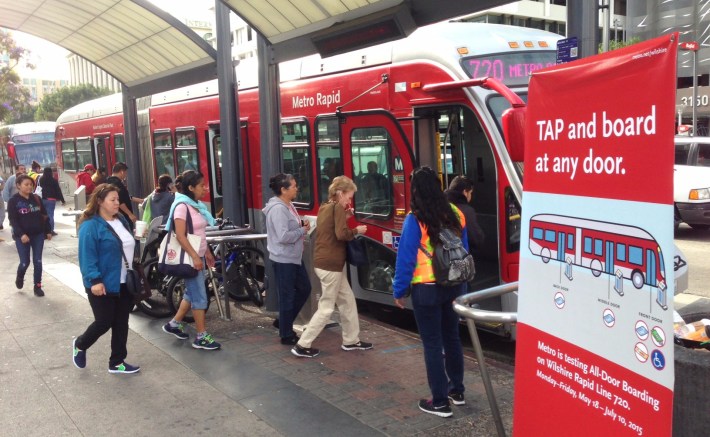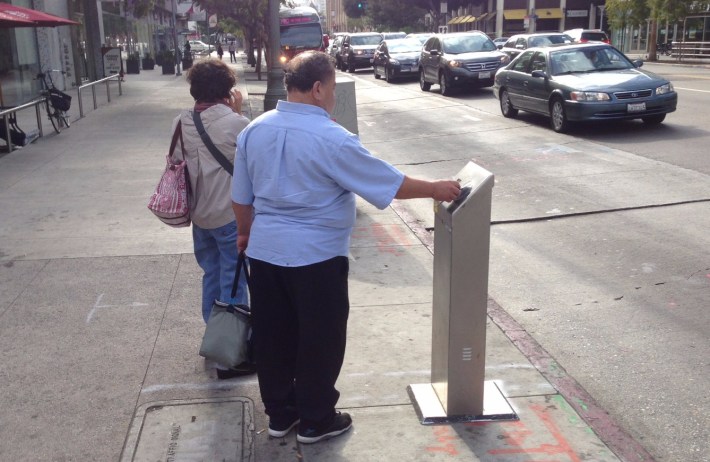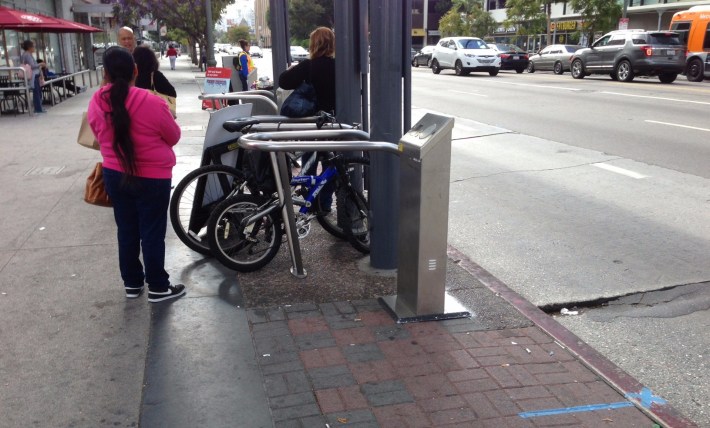
Metro is in its third week of an all-door boarding pilot at two stops on the 720 Wilshire Rapid Bus line. Riders can take advantage of all-door boarding mornings westbound at Wilshire/Vermont and afternoons eastbound at Wilshire/Westwood.
Streetsblog checked out how it was working this morning, and it looks great!
Here's how Metro's trial works:
Signage and Metro staff are on hand to explain the pilot. Today it appeared that many riders boarding the 720 had already figured it out, so staff did not have a lot to do.

Temporary TAP stanchions have been placed at locations corresponding to all three bus doors.

There's a taped stop line to help the bus driver align with the stanchions. Actually, there are two stop lines and an extra fourth TAP stanchion, in case a car is blocking the bus from the forward line.

Mostly people TAP when they see the bus coming. Then they board the nearest door.
Wheelchair users, transfers, and cash payments have to use the front door. There's no real provision to prevent fare evasion though. Theoretically someone could evade payment by boarding a back door, then claim to have paid cash. In about an hour, I noticed only two riders fail to TAP, apparently evading fare payment. This was in the presence of four Metro staff--five, counting the driver.
https://youtube.com/watch?v=TNIblkXB_tc
All-door boarding appeared to proceed very quickly this morning. A Metro video comparing before and after shows front-door boarding taking 69 seconds, and all-door boarding taking only 31 seconds.
All-door boarding comes standard in many civilized nations. New York City does all-door boarding on its Select Bus Service lines. Since July 2012, San Francisco Municipal Transportation Authority (SFMTA) has all-door boarding all throughout its bus system.
![San Francisco rear-door electronic fare payment validator. Image via SFMTA [PDF]](https://lede-admin.la.streetsblog.org/wp-content/uploads/sites/50/2015/06/SFonboardcardreader.png?w=337)
In San Francisco, riders validate fare payment cards via on-board validators located on the bus at every door. Riders who pay cash at the front door receive a paper transfer slip that serves as proof of payment. Similar to Metro rail and BRT, law enforcement occasionally checks for fare payment.
SFMTA has thoroughly reviewed the effects that all-door boarding has had on their bus system. Their extensive evaluation report [PDF], summarized here by SBSF, states that the agency "legalized an informal practice that had developed organically in response to front-door queues, crowding, and slow service." In comparing data before and after the implementation of all-door boarding, SFMTA found a slight decrease in fare evasion, coupled with faster bus service: faster boarding, shorter (and more consistent) bus dwell time, and slightly improved overall bus speeds.
The SFMTA report concludes "The success of All-Door Boarding in San Francisco’s operating environment demonstrates the potential benefits of this policy for other cities that are exploring cost effective opportunities to speed up transit."






